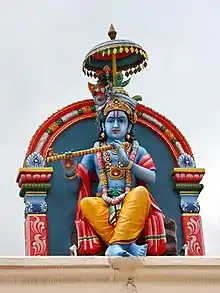Vāsudeva
Vāsudeva (Sanskrit: वासुदेव, IAST: Vāsudeva), later incorporated as Vāsudeva-Krishna (Vāsudeva-Kṛṣṇa, "Krishna, son of Vasudeva"),[5][6][7] Krishna-Vāsudeva or simply Krishna, was the son of Vasudeva Anakadundubhi, king of the Vrishnis in the region of Mathura.[8] He was a leading member of the Vrishni heroes, and may well have been an historical ruler in the region of Mathura.[8][9][10][11]
| Vāsudeva | |
|---|---|
 Vāsudeva on a coin of Agathocles of Bactria, circa 190–180 BCE.[1][2] This is "the earliest unambiguous image" of the deity.[3] | |
| Weapon | Sudarshana Chakra Kaumodaki |
| Personal information | |
| Born | |
| Parents | Devaki (mother) Vasudeva Anakadundubhi (father) |
| Siblings | Saṃkarṣaṇa (brother) Subhadra (sister) |
| Children | Pradyumna, Samba |
| Vrishni heroes |
|---|
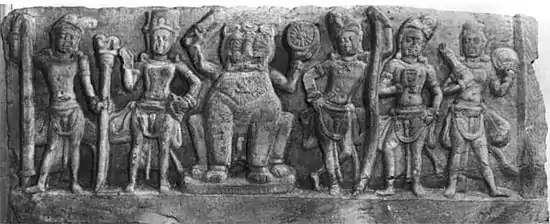 |
Vāsudevism arose with the decline of Vedism in India, which occurred during the 8th to 6th century BCE.[12] Vāsudeva then became the object of one of the earliest forms of personal deity worship in India, and is attested from around the 4th century BCE.[13][14][15] At that time, Vāsudeva was already considered as a deity, as he appears in Pāṇini's writings in conjunction with Arjuna as an object of worship, since Pāṇini explains that a vāsudevaka is a devotee (bhakta) of Vāsudeva.[16][17]
By the end of the 2nd century BCE, Vāsudeva was considered as Devadeva, the "God of Gods", the Supreme Deity, whose emblem was the mythical bird Garuda, as known from the Heliodorus pillar inscription.[18][19] This pillar, offered by the Greek ambassador and devotee Heliodorus, also shows that Vāsudeva even received dedications from the Indo-Greeks, who also represented him on the coinage of Agathocles of Bactria (190–180 BCE). The Heliodorus pillar, joining earth, space and heaven, is thought to symbolize the "cosmic axis" and express the cosmic totality of the Deity.[18] Next to the pillar, a large Temple of Vāsudeva was discovered, where he was celebrated together with his deified kinsmen, the Vrishni heroes.[18]
The cult of Vāsudeva was one of the major independent cults, together with the cults of Narayana, Shri and Lakshmi, which later coalesced to form Vaishnavism.[1] After the cult of Vāsudeva had been established, the tribe of the Vrishnis fused with the tribe of the Yadavas, who had their own hero-god named Krishna.[7] The early Krishna is known from the Mahabharata, where he is described as the chief of the Yadavas kingdom of Dvārakā (modern Dwarka in Gujarat).[7] The fused cult of Vāsudeva-Krishna became one of the significant traditions of the early history of Krishnaism, becoming a major component of the amalgamated worship of Krishna, the 8th incarnation of Vishnu.[9] According to the Vaishnavite doctrine of the avatars, Vishnu takes various forms to rescue the world, and Vāsudeva-Krishna became understood as one of these forms, and one of the most popular ones.[20] This process lasted from the 4th century BCE when Vāsudeva was an independent deity, to the 4th century CE, when Vishnu became much more prominent as the central deity of an integrated Vaishnavite cult, with Vāsudeva-Krishna now only one of his manifestations.[20]
"Vāsudeva" is the first name to appear in the epigraphical record and in the earliest literary sources such as the writings of Pāṇini.[5] It is unknown at what point of time precisely Vāsudeva came to be associated with "Krishna".[21] The association between the names "Vāsudeva" and "Krishna" starts to appear with the Mahabharata and the Harivamsa, both completed in the 3rd century CE, where "Vāsudeva" appears as the patronymic of Krishna, his father being called Vasudeva Anakadundubhi in these writings.[5] "Vāsudeva-Krishna" refers to "Krishna, son of Vasudeva", "Vāsudeva" in the lengthened form being a vṛddhi-derivative of the short form "Vasudeva" standing for Vasudeva Anakadundubhi, a type of formation very common in Sanskrit signifying "of, belonging to, descended from".[22]
Evolution

._Bilingual_series._BASILEWS_AGAQOKLEOUS_with_Indian_god_Balarama-Samkarshana.jpg.webp)
The object of the Vāsudeva worship was initially the warrior hero of the Vrishni clan named Vāsudeva. Vāsudeva later became known as Krishna, who is "Vāsudeva" (i.e. "the son of Vasudeva", ie Vasudeva Anakadundubhi), a king of the Vrishni clan in the region of Mathura. Vāsudeva, historically is believed to be part of the Vrishni or Satvata tribe, and according to them his followers called themselves Bhagavatas. This religion formed between the 4th century BC and the 2nd century BC (the time of Patanjali), according to evidence in Megasthenes and in the Arthashastra of Kautilya, when Vāsudeva was worshiped as supreme Deity in a strongly monotheistic format, where the supreme Being was perfect, eternal and full of grace.[24] In many sources outside of the cult, devotee or bhakta is defined as Vāsudevaka.[25]
Evolution as a deity

The cult of Vāsudeva may have evolved from the worship of a historical figure belonging to the Vrishni clan in the region of Mathura.[1] He is known as a member of the five "Vrishni heroes".[1]
It is thought that the hero deity Vāsudeva may have evolved into a Vaishnavite deity through a step-by-step process: 1) deification of the Vrishni heroes, of whom Vāsudeva was the leader 2) association with the God Narayana-Vishnu 3) incorporation into the Vyuha concept of successive emanations of the God.[26] In literature, the Vrishni heroes and Vāsudeva are mentioned by Pāṇini in Astadhyayi verse 6.2.34 around the 4th century BCE, while Krishna is referred to as Krishna Varshneya in verse 3.187.51 of the Mahabharata.[27] Epigraphically, the deified status of Vāsudeva is confirmed by his appearance on the coinage of Agathocles of Bactria (190–180 BCE) and by the devotional character of the Heliodorus pillar inscription.[28] Later, the association with Narayana (Vishnu) is confirmed by the Hathibada Ghosundi Inscriptions of the 1st century BCE.[28] It is generally thought that "by the beginning of the Christian era, the cult of Vāsudeva, Vishnu and Narayana amalgamated".[29] By the 2nd century CE, the "avatara concept was in its infancy", and the depiction of the four emanations of Vishnu (the Chatur-vyūha), consisting in the Vrishni heroes including Vāsudeva and minus Samba, starts to become visible in the art of Mathura at the end of the Kushan period.[30]
The Harivamsa describes intricate relationships between Krishna Vāsudeva, Sankarsana, Pradyumna and Aniruddha that would later form a Vaishnava concept of primary quadrupled expansion, or chatur vyuha.[31]
Vāsudeva is also associated with the qualities of gentleness and strength.[32]
Fusion with other traditions
The tradition of Vāsudeva-Krishna is considered as separate from other ancient traditions such as that of Gopala-Krishna, with which it amalgamated at a later stage of the historical development.[9] Some early scholars equate it with Bhagavatism.[33] The cult of Krishna Vāsudeva ultimately merged with various traditions such as Bhagavatism, the cult of Gopala-Krishna or the cult of Bala-Krishna, to form the basis of the current tradition of monotheistic religion of Krishna:
"Present day Krishna worship is an amalgam of various elements. According to historical testimonies Krishna-Vāsudeva worship already flourished in and around Mathura several centuries before Christ. A second important element is the cult of Krishna Govinda. Still later is the worship of Bala-Krishna, the Divine Child Krishna - a quite prominent feature of modern Krishnaism. The last element seems to have been Krishna Gopijanavallabha, Krishna the lover of the Gopis, among whom Radha occupies a special position. In some books Krishna is presented as the founder and first teacher of the Bhagavata religion."
An Indian Herakles
.jpg.webp)
Arrian in his work Indica, quotes the earlier work of the same name by Megasthenes which claims that Herakles, son of Zeus had come to India and was honoured by the locals as an 'indigenous' Indian deity. This reference is understood to be to Vāsudeva. [36]
But Heracles, whom tradition states to have arrived as far as India, was called by the Indians themselves 'Indigenous.' This Heracles was chiefly honoured by the Surasenians, an Indian tribe, among whom are two great cities, Methora and Cleisobora, and the navigable river Iobares flows through their territory.
However Arrian himself does not consider the stories about Herakles credible, stating:
If anyone believes this, at least it must be some other Heracles, not he of Thebes, but either of Tyre or of Egypt, or some great king of the higher inhabited country near India.
— Para V, ibid[37]
It has been proposed that Megasthenes misheard the words "Hari-Krishna" as "Herakles".[36] According to Upinder Singh, "Vāsudeva-Krishna was the Indian God bearing the closest resemblance to the Greek God Herakles".[1]
Heliodorus pillar and Temple of Vāsudeva (circa 115 BCE)
The cult of Vāsudeva soon extended well beyond the area of Mathura, as shown by the Heliodorus pillar, established by an Indo-Greek ambassador to the court of an Indian king in Vidisha, in the name of Vāsudeva.[1]
In the Heliodorus pillar, Vāsudeva is described as Deva deva, the "God of Gods", the Supreme Deity.[41] According to Harry Falk, making dedications to foreign gods was a logical practice for the Greeks, in order to appropriate their power: "Venerating Vāsudeva, as did Heliodor in the time of Antialkidas, should not be regarded as a "conversion" to Hinduism, but rather as the result of a search for the most helpful local powers, upholding own traditions in a foreign garb."[42]
A large temple, probably dedicated to Vāsudeva or the Vrishni heroes, was also discovered next to the Heliodorus pillar at Vidisha.[43][44] The Temple measured 30x30 meters, and the walls were 2.4 meters thick. Pottery finds confirmed that the Temple dated to the 2nd century BCE. [45] An earlier and smaller elliptic temple structure underneath probably dates to the end of the 3rd century BCE.[46]
Naneghat inscription (1st century BCE)
The Naneghat inscription, dated to the 1st century BCE, mentions both Samkarshana and Vāsudeva, along with the Vedic deities of Indra, Chandra, and the four Lokapala guardians Yama, Varuna and Kubera and Vāsava.[47] This provided the link between Vedic tradition and the Vaishnava tradition.[48][49][50] Given it is inscribed in stone and dated to 1st-century BCE, it also linked the religious thought in the post-Vedic centuries in late 1st millennium BCE with those found in the unreliable highly variant texts such as the Puranas dated to later half of the 1st millennium CE. The inscription is a reliable historical record, providing a name and floruit to the Satavahana dynasty.[47][49][51]

The first dedicatory sentence in the inscription mentions:
Praise (Sidham) to Dharma, adoration to Indra, adoration to Samkarshana and Vāsudeva the descendants of the Moon ("Chandra") endowed with majesty, and to the four guardians of the world ("Lokapalas"), Yama, Varuna, Kubera and Vasava; praise to Vedisri, the best of royal princes ("kumara")!
Gosundi inscription
Vāsudeva and Samkarshana are also mentioned in the 1st century BCE Hathibada Ghosundi Inscriptions:[1]
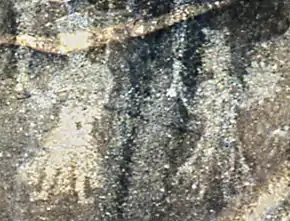
(This) enclosing wall round the stone (object) of worship, called Narayana-vatika (Compound) for the divinities Samkarshana-Vāsudeva who are unconquered and are lords of all (has been caused to be made) by (the king) Sarvatata, a Gajayana and son of (a lady) of the Parasaragotra, who is a devotee of Bhagavat (Vishnu) and has performed an Asvamedha sacrifice.
– Ghosundi Hathibada Inscriptions, 1st-century BCE[54]
Chilas petroglyphs
At Chilas II archeological site dated to the first half of 1st-century CE in northwest Pakistan, near the Afghanistan border, are engraved two males along with many Buddhist images nearby. The larger of the two males holds a plough and club in his two hands. The artwork also has an inscription with it in Kharosthi script, which has been deciphered by scholars as Rama-Krsna, and interpreted as an ancient depiction of the two brothers Balarama and Krishna.[55][56]
Vāsudeva Temple in Mathura (circa 15 CE)

The Vasu Doorjamb Inscription is a significant early Sanskrit inscription from Mathura. The mention of Sodasa's time who, states Salomon, is "dated with reasonable certainty to the early early years of the first century AD".[58] Its mention of Vasu, temple, Vedika and a torana (gateway) is significant as it confirms that the large temple building tradition was in vogue in the Mathura region by at least the start of the common era. Further, it also attests to the popularity of the Vāsudeva tradition in this period.[59][60] The Vasu Doorjamb inscription of Sodasa in Uttar Pradesh viewed with other epigraphical evidence such as the Besnagar Heliodorus pillar in Madhya Pradesh, the Hathibada Ghosundi Inscriptions in Rajasthan, and the Naneghat inscriptions in Maharashtra suggest that the cult of Vāsudeva had spread over a wide region by the 1st-century BCE to the start of common era.[60][61]
According to Quintanilla, the Vasu Doorjamb and the inscription is "one of the most important and most beautiful objects" from the time of Sodasa, likely from a "temple to Vāsudeva".[62] The carvings on the doorjamb are three woven compositions. It has a leafy vine that runs along the length of the red sandstone jamb. Along the stem of the vine are curling leaves and blossoms, that wrap along as those found in nature, a rosette added in where the intertwining vines meet.[63][64] The wider band has lotus rhizome carved in, with subtle naturalistic variations, wherein the lotus flowers are shown in all their stages of bloom, states Quintanilla.[63]
Vāsudeva in 2nd century CE sculpture
Some sculptures during this period suggest that the concept of the avatars was starting to emerge, as images of "Chatur-vyūha" (the four emanations of Vishnu) are appearing.[65] The famous "Caturvyūha Viṣṇu" statue in Mathura Museum is an attempt to show in one composition Vāsudeva (avatar of Vishnu) together with the other members of the Vrishni clan of the Pancharatra system: Samkarsana, Pradyumna and Aniruddha, with Samba missing, Vāsudeva being the central deity from whom the others emanate.[10] The back of the relief is carved with the branches of a Kadamba tree, symbolically showing the relationship being the different deities.[10] The depiction of Vishnu was stylistically derived from the type of the ornate Bodhisattvas, with rich jewelry and ornate headdress.[66]
Two Kushan Empire emperors were named after Vāsudeva: Vāsudeva I (191–232 CE) and Vāsudeva II (275–300 CE).[67]
Vāsudeva in the Kondamotu relief (4th century CE)
Vāsudeva appears prominently in a relief from Kondamotu, Guntur district in Andhra Pradesh, dating to the 4th century CE, which shows the Vrishni heroes standing in genealogical order around Narasimha.[68][69] Vāsudeva follows Saṃkarṣaṇa, being second from the left in the place of seniority, with a hand in abhaya mudra and the other hand on the hip holding a conch shell.[68] Vāsudeva also has a crown, which distinguishes him from the others.[70] Then follow Pradyumna, holding a bow and an arrow, Samba, holding a wine goblet, and Aniruddha, holding a sword and a shield.[68] The fact that they stand around Narasimha suggests a fusion of the Satvata cult with the Vrishni cult at this point.[68]
Transition from Vāsudeva to Vishnu (4th–5th century CE)
Iconographic transition

Various early statues showing a deity with the attributes of Vāsudeva have long been attributed to Vishnu.[71] But it is now thought that statues dedicated to the worship of Vishnu only started to appear from the 4th century CE during the Gupta Empire period, derived from, and using the attributes of Vāsudeva, but adding an aureole starting at the shoulders: the Vishnu Caturanana ("Four-Armed Vishnu") statues.[71] The statues before the 4th century CE have been reattributed to Vāsudeva, a period during which Vāsudeva seems to have been much more important than Vishnu.[71]
Other statues of Vishnu show him as three-headed (with an implied fourth head in the back), the Visnu Vaikuntha Chaturmurti or Chaturvyuha ("Four-Emanations") type, where Vishnu has a human head, flanked by the muzzle of a boar (his avatar Varaha) and the head of a lion (his avatar Narasimha), two of his most important and ancient avatars, laid out upon his aureole.[71] Recent scholarship considers that these "Vishnu" statues still show the emanation Vāsudeva Krishna as the central human-shaped deity, rather than the Supreme God Vishnu himself.[72][71]
Theological transition
Over centuries, the cult of Vāsudeva transformed into Vaishnavism.[73] Overall, "Vaishnavite Hinduism is believed to have originated in the 4th century BC in the cult of Vāsudeva-Krishna, which was then grafted in the 2nd century AD onto the cult of Narayana. By the 4th century, Vishnu's prominence increased considerably. He was now regarded as a member of the Trimurti, the cosmic triad of Gods, Brahma, Vishnu and Shiva".[74]
From the 4–5th century, Vāsudeva-Krsna is identified with Vishnu and Narayana, and fuses with Gopala-Krishna:[75]
In the Kavyas of Kalidasa we find not only Vāsudeva-Krsna identified with Vishnu and Narayana, but Krsna is also called Gopala-Krsna. He has obtained the Kaustubha jewel from the serpent Kaliya of the Jamuna, "wears the peacock feathers resembling the cloud adorned with rainbow", and his wife is Rukmini and his brother Balarama.
— Radhakamal Mukerjee[75]
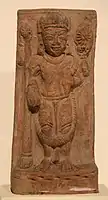 Vāsudeva with four attributes and without an aureole, terracotta[71]
Vāsudeva with four attributes and without an aureole, terracotta[71]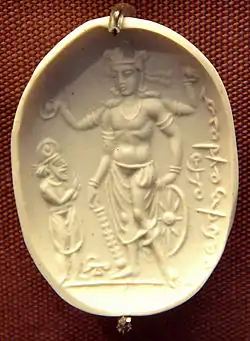

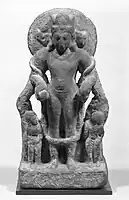 Four-faced four-armed Vishnu Vaikuntha Chaturmurti, still showing Vāsudeva Krishna as the central human figure, 4th–5th century, Mathura[72][71]
Four-faced four-armed Vishnu Vaikuntha Chaturmurti, still showing Vāsudeva Krishna as the central human figure, 4th–5th century, Mathura[72][71] Four-armed Seated Vishnu (with the aureole) in meditation, Medieval Period
Four-armed Seated Vishnu (with the aureole) in meditation, Medieval Period
Vāsudeva at Deogarh (6th century CE)
The Dashavatara Temple in Deogarh is closely related to the iconic architectural temple structure described in the Viṣṇudharmottara purāṇa, and can be interpreted as an architectural representation of the Caturvyuha concept and the Pancaratra doctrine, centering on the depictions of the four main emanations of Vishnu: Vāsudeva, Samkarshana, Pradyumna and Aniruddha.[77] According to Lubotsky, it is likely that the entrance is dedicated to the Vāsudeva aspect of Vishnu; the Anantashayana side is his role as the creator (Aniruddha); the sage form of Nara-Narayana side symbolizes his preservation and maintainer role in cosmic existence (Pradyumna); and the Gajendramoksha side represents his role as the destroyer (Samkarsana).[77]
Vasudev

To this day, a group of religious mendicants known as Vasudevs are people believed to be incarnation of Lord Krishna. Bedecked in the distinctive headgear of peacock feathers, performers sing Vasudev songs and with nimble, delicate dance steps, whirl around presenting anecdotes from Lord Krishna's life in exchange for alms. They sing soothing, melodious notes through the villages in the morning time.[79]
"The Vasudevs, the village mendicants, also live on the alms they get from the villagers. The religious cult from which this art form originated was that of Vasudev-Krishna which was in existence in the fourth century B.C. It gained popularity only after the first century B.C., and in subsequent centuries it was absorbed into the wider religious framework of Vaisnavism"
— Narayana Menon[80]
Devotion
A popular short prayer for worshipping Vāsudeva is Dvadasakshari ("the twelve-syllable mantra"), consisting in the recitation of the phrase "Om Namo Bhagavate Vāsudevāya" (ⓘ) (in devanagari: ॐ नमो भगवते वासुदेवाय), which is one of the most popular Hindu mantras, and one of the most important mantras in Vaishnavism. It means "Om, I bow to Lord Vāsudeva", who is variously understood as Krishna or Vishnu.[81][82]
See also
Notes
| Part of a series on |
| Vaishnavism |
|---|
 |
| Vyūhas | Image | Attributes | Symbol[86][87] | Direction | Face | Concept | |||
|---|---|---|---|---|---|---|---|---|---|
| Narayana Vishnu |
Vāsudeva | Chakra Wheel Gadā Mace Shankha Conch |
Garuda Eagle |  |
East | Saumya (Placid/ benevolent) |
Jṅāna Knowledge | ||
| Samkarsana | Lāṅgala Plough Musala Pestle Wine glass |
Tala Fan palm |  |
South | Simha Lion | Bala Strength | |||
| Pradyumna | Cāpa Bow Bāṇa Arrow |
Makara Crocodile | West | Raudra Kapila | _(cropped).jpg.webp) |
Aiśvaryā Sovereignty | |||
| Aniruddha | Carma Shield Khaḍga Sword |
Ṛṣya (ऋष्य) White-footed antelope | North | Varaha Boar | Śakti Power | ||||
References
- Singh, Upinder (2008). A History of Ancient and Early Medieval India: From the Stone Age to the 12th Century. Pearson Education India. p. 436–438. ISBN 978-81-317-1120-0.
- Osmund Bopearachchi, Emergence of Viṣṇu and Śiva Images in India: Numismatic and Sculptural Evidence, 2016.
- Srinivasan, Doris (1997). Many Heads, Arms, and Eyes: Origin, Meaning, and Form of Multiplicity in Indian Art. BRILL. p. 215. ISBN 978-90-04-10758-8.
- Raychaudhuri 1972, p. 124
- "While the earliest piece of evidence do not yet use the name Krsna...." in Austin, Christopher R. (2019). Pradyumna: Lover, Magician, and Son of the Avatara. Oxford University Press. p. 23. ISBN 978-0-19-005411-3.
- At the time of the Heliodorus pillar dedication to Vāsudeva in 115 BCE: "The real question, however, remains: was Vãsudeva already identified with Krsna?" Puskás, Ildikó (1990). "Magasthenes and the "Indian Gods" Herakles and Dionysos". Mediterranean Studies. 2: 43. ISSN 1074-164X. JSTOR 41163978.
- Flood, Gavin D. (1996). An Introduction to Hinduism. Cambridge University Press. pp. 119–120. ISBN 978-0-521-43878-0.
- Vāsudeva and Krishna "may well have been kings of this dynasty as well" in Rosenfield, John M. (1967). The Dynastic Arts of the Kushans. University of California Press. p. 151–152 and Fig.51.
- Williams, Joanna Gottfried (1981). Kalādarśana: American Studies in the Art of India. BRILL. p. 129. ISBN 978-90-04-06498-0.
- Paul, Pran Gopal; Paul, Debjani (1989). "Brahmanical Imagery in the Kuṣāṇa Art of Mathurā: Tradition and Innovations". East and West. 39 (1/4): 132–136, for the photograph p.138. ISSN 0012-8376. JSTOR 29756891.
- Smagur, Emilia. "Vaishnavite Influences in the Kushan Coinage, Notae Numismaticae- Zapiski Numizmatyczne, X (2015)": 67.
{{cite journal}}: Cite journal requires|journal=(help) - "The theistic cult centered on bhakti for the deified Vṛṣṇi hero Vāsudeva, who is not mentioned in any early text. With the decline of Vedism, the cult emerged as a significant force. Strangely, the available evidence shows that the worship of Vāsudeva, and not that of Viṣṇu, marks the beginning of what we today understand by Vaiṣṇavism." in Eliade, Mircea; Adams, Charles J. (1987). The Encyclopedia of religion. Macmillan. p. 168. ISBN 978-0-02-909880-6.
- Doris Srinivasan (1997). Many Heads, Arms, and Eyes: Origin, Meaning, and Form of Multiplicity in Indian Art. BRILL Academic. pp. 211–220, 236. ISBN 90-04-10758-4.
- Gavin D. Flood (1996). An Introduction to Hinduism. Cambridge University Press. pp. 119–120. ISBN 978-0-521-43878-0.
- Christopher Austin (2018). Diana Dimitrova and Tatiana Oranskaia (ed.). Divinizing in South Asian Traditions. Taylor & Francis. pp. 30–35. ISBN 978-1-351-12360-0.
- Malpan, Varghese (1992). A Comparative Study of the Bhagavad-gītā and the Spiritual Exercises of Saint Ignatius of Loyola on the Process of Spiritual Liberation. Gregorian Biblical BookShop. pp. 57–58. ISBN 978-88-7652-648-0.
- "The affix vun comes in the sense of "this is his object of veneration" after the words 'Vâsudeva' and 'Arjuna'", giving Vâsudevaka and Arjunaka. Source: Aṣṭādhyāyī 2.0 Panini 4-3-98
- Approaches to Iconology. Brill Archive. 1985. p. 41. ISBN 978-90-04-07772-0.
- Malpan, Varghese (1992). A Comparative Study of the Bhagavad-gītā and the Spiritual Exercises of Saint Ignatius of Loyola on the Process of Spiritual Liberation. Gregorian Biblical BookShop. p. 58. ISBN 978-88-7652-648-0.
- Curta, Florin; Holt, Andrew (2016). Great Events in Religion: An Encyclopedia of Pivotal Events in Religious History [3 volumes]. ABC-CLIO. p. 271. ISBN 978-1-61069-566-4.
- At the time of the Heliodorus pillar dedication to Vāsudeva in 115 BCE: "The real question, however, remains: was Vãsudeva already identified with Krsna?" Puskás, Ildikó (1990). "Magasthenes and the "Indian Gods" Herakles and Dionysos". Mediterranean Studies. 2: 43. ISSN 1074-164X. JSTOR 41163978.
- Fortson (2004:116f)
- Gupta, Vinay K. (January 2019). "Vrishnis in Ancient Literature and Art". Indology's Pulse Arts in Context, Doris Meth Srinivasan Festschrift Volume, Eds. Corinna Wessels Mevissen and Gerd Mevissen with Assistance of Vinay Kumar Gupta: 70–72.
- Hastings 2003, pp. 540–42
- SINGH, R.R. (2007). Bhakti And Philosophy. Lexington Books. ISBN 978-0-7391-1424-7. :p. 10: "[Panini's] term Vāsudevaka, explained by the second century B.C commentator Patanjali, as referring to 'the follower of Vāsudeva, God of gods.'"
- Srinivasan, Doris (1979). "Early Vaiṣṇava Imagery: Caturvyūha and Variant Forms". Archives of Asian Art. 32: 50. JSTOR 20111096.
- Joanna Gottfried Williams (1981). Kalādarśana: American Studies in the Art of India. BRILL. pp. 127–131. ISBN 90-04-06498-2.
- Srinivasan, Doris (1979). "Early Vaiṣṇava Imagery: Caturvyūha and Variant Forms". Archives of Asian Art. 32: 51. ISSN 0066-6637. JSTOR 20111096.
- Subburaj, V.V.K. (2004). Basic Facts of General Knowledge. Sura Books. p. 68. ISBN 978-81-7254-234-4.
- Singh, Upinder (2008). A History of Ancient and Early Medieval India: From the Stone Age to the 12th Century. Pearson Education India. p. 439. ISBN 978-81-317-1677-9.
- "Lord Balaram, the source of the Vishnu Murtis". ISKCON Vrindavan. 8 August 2019. Retrieved 3 November 2020.
- "Gentleness and strength are associated with Vāsudeva, knowledge with Samkarsana, (Narasimha) female power with Pradyumna (Varaha) and ferociousness and sovereignty with Aniruddha (Kapila)." Kamalakar, G.; Veerender, M. (1993). Vishnu in Art, Thought & Literature. Birla Archeological & Cultural Research Institute. p. 92.
- Hastings 2003, p. 540
- KLOSTERMAIER, Klaus K. (2005). A Survey of Hinduism. State University of New York Press; 3 edition. p. 206. ISBN 0-7914-7081-4.
Present day Krishna worship is an amalgam of various elements. According to historical testimonies Krishna-Vāsudeva worship already flourished in and around Mathura several centuries before Christ. A second important element is the cult of Krishna Govinda. Still later is the worship of Bala-Krishna, the Divine Child Krishna - a quite prominent feature of modern Krishnaism. The last element seems to have been Krishna Gopijanavallabha, Krishna the lover of the Gopis, among whom Radha occupies a special position. In some books Krishna is presented as the founder and first teacher of the Bhagavata religion.
- BASHAM, A. L. "Review:Krishna: Myths, Rites, and Attitudes. by Milton Singer; Daniel H. H. Ingalls, The Journal of Asian Studies, Vol. 27, No. 3 (May, 1968), pp. 667-670". JSTOR 2051211.
{{cite journal}}: Cite journal requires|journal=(help) - Bryant, Edwin Francis (2007). Krishna: A Sourcebook. Oxford University Press. p. 5–6. ISBN 978-0-19-803400-1.
- Arrian, Tr. E. Iliff Robson (1933). Anabasis Alexandri, Book VIII (Indica). Retrieved 24 September 2021.
- Approaches to Iconology. Brill Archive. 1985. p. 41. ISBN 978-90-04-07772-0.
- Ghosh, A. (1967). Indian Archaeology 1963-64, A Review. ASI. p. 17. doi:10.5281/zenodo.3416858.
- Archaeological Survey Of India (1965). Indian Archaeology -- A Review 1964-65. p. 19-20, BSN-3. doi:10.5281/zenodo.1442629.
- Barnett, Lionel (2017). Hindu Gods and Heroes. Jovian Press. p. 40. ISBN 978-1-5378-1391-2.
- Falk, Harry. Greek style dedications. p. 40.
- Approaches to Iconology. Brill Archive. 1985. p. 41. ISBN 978-90-04-07772-0.
- Blurton, T. Richard (1993). Hindu Art. Harvard University Press. p. 50. ISBN 978-0-674-39189-5.
- Ghosh, A. (1967). Indian Archaeology 1963-64, A Review. ASI. p. 17. doi:10.5281/zenodo.3416858.
- Archaeological Survey Of India (1965). Indian Archaeology -- A Review 1964-65. p. 19-20, BSN-3. doi:10.5281/zenodo.1442629.
- Charles Allen 2017, pp. 169–170.
- Joanna Gottfried Williams (1981). Kalādarśana: American Studies in the Art of India. BRILL Academic. pp. 129–130. ISBN 90-04-06498-2.
- Mirashi 1981, pp. 131–134.
- Edwin F. Bryant (2007). Krishna: A Sourcebook. Oxford University Press. pp. 18 note 19. ISBN 978-0-19-972431-4.
- Vincent Lefèvre (2011). Portraiture in Early India: Between Transience and Eternity. BRILL Academic. pp. 33, 85–86. ISBN 978-9004207356.
- Burgess, Jas (1883). Report On The Elura Cave Temples And The Brahmanical And Jaina Caves In Western India. pp. 60–61.
- Srinivasan, Doris (1997). Many Heads, Arms, and Eyes: Origin, Meaning, and Form of Multiplicity in Indian Art. BRILL. p. 215. ISBN 978-90-04-10758-8.
- D. R. Bhandarkar, Hathi-bada Brahmi Inscription at Nagari, Epigraphia Indica Vol. XXII, Archaeological Survey of India, pages 198-205
- Doris Srinivasan (1997). Many Heads, Arms, and Eyes: Origin, Meaning, and Form of Multiplicity in Indian Art. BRILL Academic. pp. 214–215 with footnotes. ISBN 90-04-10758-4.
- Jason Neelis (2010). Early Buddhist Transmission and Trade Networks: Mobility and Exchange Within and Beyond the Northwestern Borderlands of South Asia. BRILL Academic. pp. 271–272. ISBN 978-90-04-18159-5.
- Quintanilla, Sonya Rhie (2007). History of Early Stone Sculpture at Mathura: Ca. 150 BCE - 100 CE. BRILL. p. 171. ISBN 9789004155374.
- Richard Salomon 1998, pp. 87–88.
- Ramaprasad Chanda 1920, p. 170.
- Upinder Singh 2008, p. 437.
- Ramaprasad Chanda 1920, pp. 169–173.
- Quintanilla, Sonya Rhie (2007). History of Early Stone Sculpture at Mathura: Ca. 150 BCE - 100 CE. BRILL. p. 205. ISBN 978-90-04-15537-4.
- Sonya Rhie Quintanilla 2007, pp. 205–206.
- Ramesh Chandra Sharma 1994, p. 72.
- Singh, Upinder (2008). A History of Ancient and Early Medieval India: From the Stone Age to the 12th Century. Pearson Education India. p. 439. ISBN 978-81-317-1677-9.
- Bautze-Picron, Claudine (2013). "A neglected Aspect of the Iconography of Viṣṇu and other Gods and Goddesses". Journal of the Indian Society of Oriental Arts. XXVIII–XXIX: 81–92.
- Coins of India Calcutta : Association Press ; New York : Oxford University Press, 1922
- Gupta, Vinay K. (January 2019). "Vrishnis in Ancient Literature and Art". Indology's Pulse Arts in Context, Doris Meth Srinivasan Festschrift Volume, Eds. Corinna Wessels Mevissen and Gerd Mevissen with Assistance of Vinay Kumar Gupta: 74–75.
- Austin, Christopher R. (2019). Pradyumna: Lover, Magician, and Son of the Avatara. Oxford University Press. p. 27. ISBN 978-0-19-005411-3.
- Srinivasan, Doris (1997). Many Heads, Arms, and Eyes: Origin, Meaning, and Form of Multiplicity in Indian Art. BRILL. p. 217. ISBN 978-90-04-10758-8.
- For English summary, see page 80 Schmid, Charlotte (1997). "Les Vaikuṇṭha gupta de Mathura : Viṣṇu ou Kṛṣṇa?". Arts Asiatiques. 52: 60–88. doi:10.3406/arasi.1997.1401.
- "Because they date to a period when the Pancharatra sect was most influential, these two images are probably best identified as Chaturvyuha (or Four-Vyuha) Vishnu. The central face is that of Vishnu’s most supreme, most transcendent vyuha, or emanation, known as Vāsudeva. The subsequent, less abstract vyuhas, in the form of a lion and a boar, appear at either side, with another vyuha implied at the back. The positions of the lion and boar heads differ in these two pieces, indicating that there was some disagreement about the way the viewer should read such an icon." "Brooklyn Museum". www.brooklynmuseum.org.
- "The origin of Vaiṣṇavism as a theistic sect can by no means be traced back to the Ṛgvedic god Viṣṇu. In fact, Vaiṣṇavism is in no sense Vedic in origin. (...) Strangely, the available evidence shows that the worship of Vāsudeva, and not that of Viṣṇu, marks the beginning of what we today understand by Vaiṣṇavism. This Vāsudevism, which represents the earliest known phase of Vaiṣṇavism, must already have become stabilized in the days of Pāṇini (sixth to fifth centuries bce)." in Eliade, Mircea; Adams, Charles J. (1987). The Encyclopedia of religion. Macmillan. p. 168. ISBN 978-0-02-909880-6.
- Curta, Florin; Holt, Andrew (2016). Great Events in Religion: An Encyclopedia of Pivotal Events in Religious History [3 volumes]. ABC-CLIO. p. 271. ISBN 978-1-61069-566-4.
- Mukerjee, Radhakamal; Madan, Gurmukh Ram; Gupta, Viśvaprakāśa (2006). A History of Indian Civilization: Ancient and classical traditions. Radha Publications. p. 242. ISBN 978-81-7487-402-3.
- "A much better known «syncretistic» image is the one depicted on a well-known «nicolo» seal (....) Ghirshman thought of a composite deity (Mihira-Visnu-Siva, Ibidem: 55-58), although an identification with the god Vāsudeva is perhaps more likely (Mitterwallner 1986: 10)" "Silk Road Art and Archaeology: Journal of the Institute of Silk Road Studies, Kamakura". The Institute. 1996: 170.
{{cite journal}}: Cite journal requires|journal=(help) - Lubotsky, Alexander (1996). "The Iconography of the Viṣṇu Temple at Deogarh and the Viṣṇudharmottarapurāṇa". Ars Orientalis. 26: 65–80. ISSN 0571-1371. JSTOR 4629500.
- Bhanu, B. V. (2004). People of India: Maharashtra. Popular Prakashan. p. 2033–2036. ISBN 978-81-7991-100-6.
- Bhanu, B. V. (2004). People of India: Maharashtra. Popular Prakashan. p. 2033–2036. ISBN 978-81-7991-100-6.
- Menon, Narayana (1983). The performing arts. Humanities Press. p. 112. ISBN 9780391029170.
- Swami Krishnananda. "The Significance of Mantra-Japa Sadhana". swami-krishnananda.org. Retrieved 14 April 2012.
- J. Donald Walters (1 March 2002). The Art and Science of Raja Yoga: Fourteen Steps to Higher Awareness : Based on the Teachings of Paramhansa Yogananda. Crystal Clarity Publishers. pp. 251–. ISBN 978-1-56589-166-1. Retrieved 24 June 2012.
- Atherton, Cynthia Packert (1997). The Sculpture of Early Medieval Rajasthan. BRILL. p. 78. ISBN 978-90-04-10789-2.
- A Comprehensive History of India: pt. 1-2. A.D. 300-985. Orient Longmans. 1982. p. 866.
- Parlier-Renault, Edith (2007). Temples de l'Inde méridionale: VIe-VIIIe siècles. La mise en scène des mythes. Presses Paris Sorbonne. pp. 38–42. ISBN 978-2-84050-464-1.
- "A shrine of Aniruddha, the fourth of the 'vyuhas', which had within its precincts a 'rsyadhvaja', i. e. a column bearing on its top the figure of a 'rsya' or a white antelope which was his characteristic 'lanchana'." in Journal of the Indian Society of Oriental Art. Indian Society of Oriental Art. 1937. p. 16.
- Gupta, Vinay K. "Vrishnis in Ancient Literature and Art". Indology's Pulse Arts in Context, Doris Meth Srinivasan Festschrift Volume, Eds. Corinna Wessels Mevissen and Gerd Mevissen with Assistance of Vinay Kumar Gupta: 80–81.
Further reading
- Charles Allen (2017), "6", Coromandel: A Personal History of South India, Little Brown, ISBN 978-1408705391
- Mirashi, Vasudev Vishnu (1981), History and Inscriptions of the Satavahanas: The Western Kshatrapas, Maharashtra State Board for Literature and Culture
- Fortson, Benjamin W., IV (2004). Indo-European Language and Culture. Blackwell Publishing. ISBN 1-4051-0316-7.
{{cite book}}: CS1 maint: multiple names: authors list (link) - Hastings, James Rodney (2003) [1908–26]. Encyclopedia of Religion and Ethics. Vol. 4. John A Selbie (2nd ed.). Edinburgh: Kessinger Publishing, LLC. p. 476. ISBN 0-7661-3673-6. Retrieved 3 May 2008.
The encyclopedia will contain articles on all the religions of the world and on all the great systems of ethics. It will aim at containing articles on every religious belief or custom, and on every ethical movement, every philosophical idea, every moral practice.
- Hein, Norvin. "A Revolution in Kṛṣṇaism: The Cult of Gopāla: History of Religions, Vol. 25, No. 4 (May, 1986), pp. 296-317". JSTOR 1062622.
{{cite journal}}: Cite journal requires|journal=(help) - SINGER, Milton (1900). Krishna Myths Rites & Attitudes. UNIVERSITY OF CHICAGO. ISBN 0-313-22822-1.
- Delmonico, N. (2004). "The History Of Indic Monotheism And Modern Chaitanya Vaishnavism". The Hare Krishna Movement: The Postcharismatic Fate of a Religious Transplant. Columbia University Press. ISBN 978-0-231-12256-6. Retrieved 12 April 2008.
- Mahony, W.K. (1987). "Perspectives on Krsna's Various Personalities". History of Religions. 26 (3): 333–335. doi:10.1086/463085. JSTOR 198702. S2CID 164194548.
- BHATTACHARYA, Gouriswar: Vanamala of Vasudeva-Krsna-Visnu and Sankarsana-Balarama. In: Vanamala. Festschrift A.J. Gail. Serta Adalberto Joanni Gail LXV. diem natalem celebranti ab amicis collegis discipulis dedicata. Gerd J.R. Mevissen et Klaus Bruhn redigerunt. Berlin 2006; pp. 9–20.
- COUTURE, André: The emergence of a group of four characters (Vasudeva, Samkarsana, Pradyumna, and Aniruddha) in the Harivamsa: points for consideration. Journal of Indian Philosophy 34,6 (2006) 571–585.
- NP Chakravarti (1942). Epigraphia Indica, Vol. XXIV. Archaeological Survey of India.
- Ramaprasad Chanda (1920). Archaeology and Vaishnava Tradition in MASI, No. 5. Archaeological Survey of India. OCLC 715446015.
- Heinrich Lüders; Klaus Ludwig Janert (1961), Mathurā inscriptions, Göttingen : Vandenhoeck & Ruprecht, OCLC 717966622
- Sonya Rhie Quintanilla (2007). History of Early Stone Sculpture at Mathura: ca. 150 BCE - 100 CE. BRILL Academic. ISBN 978-90-04-15537-4.
- Raychaudhuri, Hemchandra (1972). Political History of Ancient India. Calcutta: University of Calcutta. Originally published in 1923.
- Sahni, Daya Ram (1917). "Annual Progress Report of the Superintendent, Hindu and Buddhist Monuments, North Circle". Issues for 1920-1921 Have Title:annual Progress Report of the Superintendent, Archæological Survey, Hindu and Buddhist Monuments, Northern Circle, for the Year Ending. Government Press Punjab, Lahore. hdl:2027/uc1.c2999464.
- Richard Salomon (1998). Indian Epigraphy: A Guide to the Study of Inscriptions in Sanskrit, Prakrit, and the other Indo-Aryan Languages. Oxford University Press. ISBN 978-0-19-535666-3.
- Ramesh Chandra Sharma (1994). The Splendour of Mathurā Art and Museum. DK Printworld. ISBN 978-81-246-0015-3.
- Upinder Singh (2008). A History of Ancient and Early Medieval India: From the Stone Age to the 12th Century. Pearson Education India. ISBN 978-81-317-1120-0.
- Joanna Williams (1982). The Art of Gupta India: Empire and Province. Princeton University Press. ISBN 978-0-691-10126-2.
- Michael Willis (2000). Buddhist Reliquaries from Ancient India. British Museum Press. ISBN 978-0-7141-1492-7.





